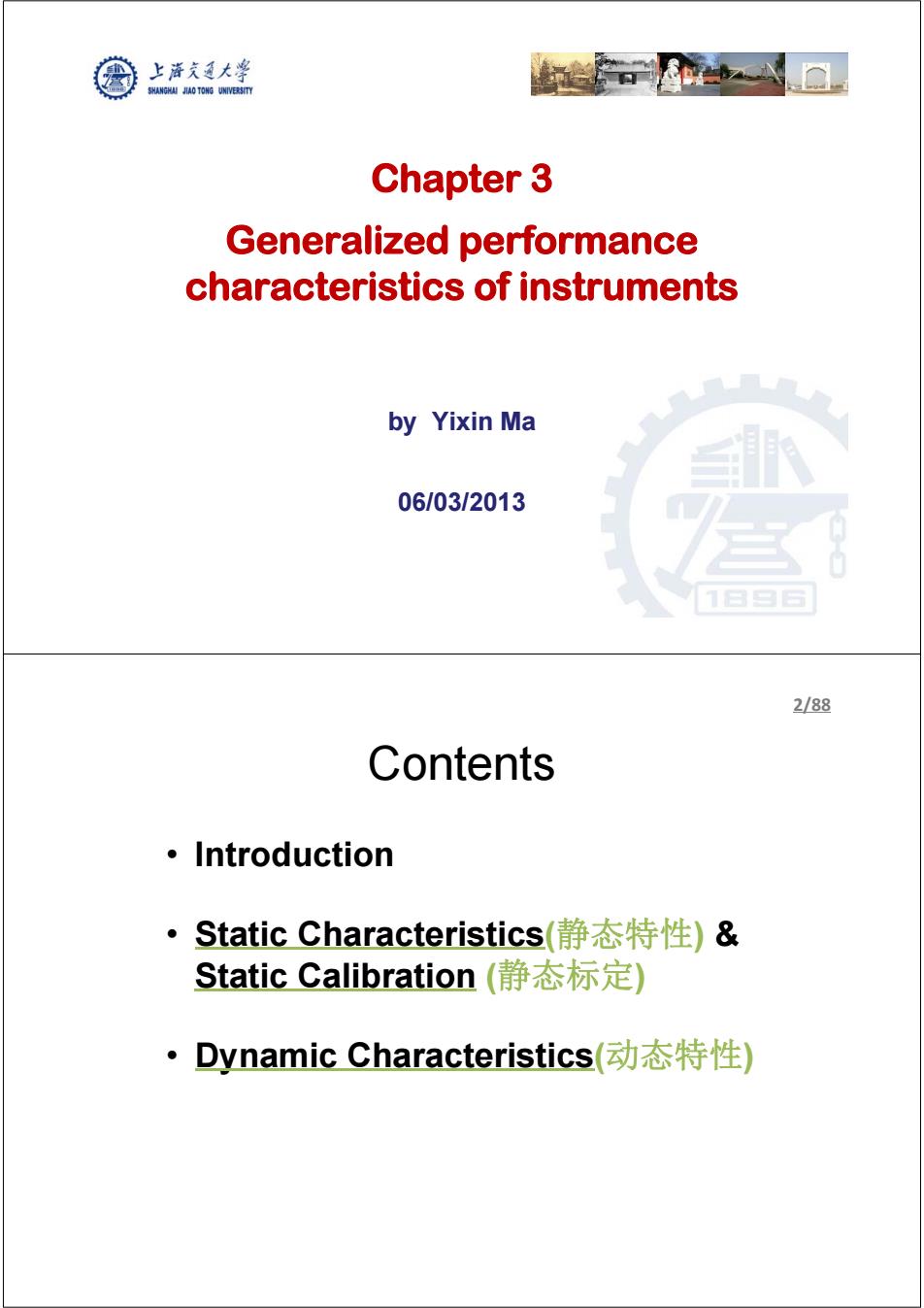
上游充通大¥ SHANGHAI JIAO TONG UNIVERSITY Chapter 3 Generalized performance characteristics of instruments by Yixin Ma 06/03/2013 2/88 Contents ·Introduction Static Characteristics(静态特性)& Static Calibration(静态标定) ·Dynamic Characteristics(动态特性)
Chapter 3 Generalized performance characteristics of instruments by Yixin Ma 06/03/2013 Contents • Introduction • Static Characteristics(静态特性) & Static Calibration (静态标定) • Dynamic Characteristics(动态特性) 2/88
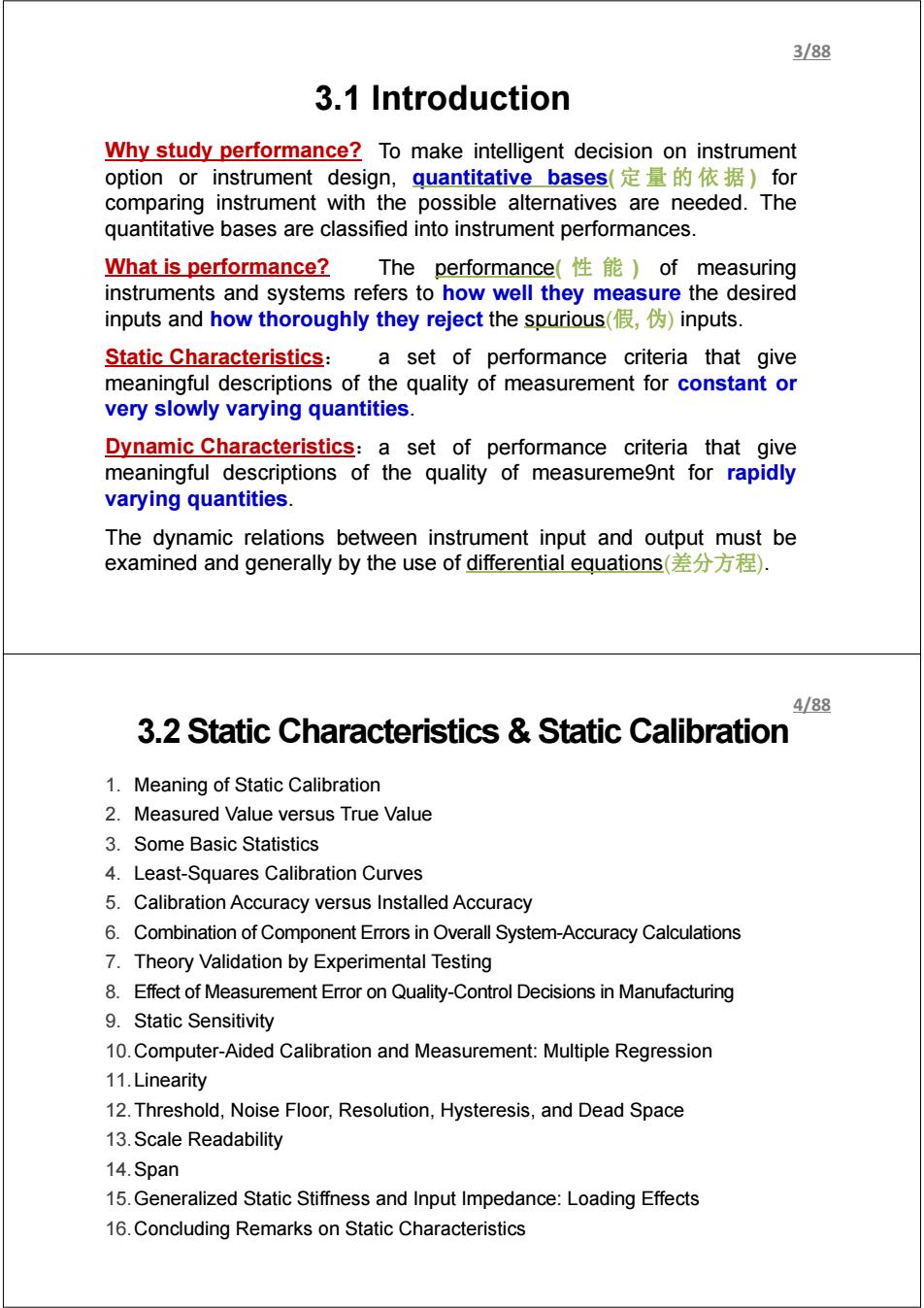
3/88 3.1 Introduction Why study performance?To make intelligent decision on instrument option or instrument design,quantitative bases定量的依据)for comparing instrument with the possible alternatives are needed.The quantitative bases are classified into instrument performances. What is performance?The performance()of measuring instruments and systems refers to how well they measure the desired inputs and how thoroughly they reject the spurious(假,f伪)inputs. Static Characteristics:a set of performance criteria that give meaningful descriptions of the quality of measurement for constant or very slowly varying quantities. Dynamic Characteristics:a set of performance criteria that give meaningful descriptions of the quality of measureme9nt for rapidly varying quantities. The dynamic relations between instrument input and output must be examined and generally by the use of differential equations(差s分方程). 4/88 3.2 Static Characteristics Static Calibration 1.Meaning of Static Calibration 2.Measured Value versus True Value 3.Some Basic Statistics 4.Least-Squares Calibration Curves 5.Calibration Accuracy versus Installed Accuracy 6.Combination of Component Errors in Overall System-Accuracy Calculations 7.Theory Validation by Experimental Testing 8.Effect of Measurement Error on Quality-Control Decisions in Manufacturing 9.Static Sensitivity 10.Computer-Aided Calibration and Measurement:Multiple Regression 11.Linearity 12.Threshold,Noise Floor,Resolution,Hysteresis,and Dead Space 13.Scale Readability 14.Span 15.Generalized Static Stiffness and Input Impedance:Loading Effects 16.Concluding Remarks on Static Characteristics
To make intelligent decision on instrument option or instrument design, quantitative bases( 定量的依据 ) for comparing instrument with the possible alternatives are needed. The quantitative bases are classified into instrument performances. The performance( 性 能 ) of measuring instruments and systems refers to how well they measure the desired inputs and how thoroughly they reject the spurious(假, 伪) inputs. a set of performance criteria that give meaningful descriptions of the quality of measurement for constant or very slowly varying quantities. a set of performance criteria that give meaningful descriptions of the quality of measureme9nt for rapidly varying quantities. The dynamic relations between instrument input and output must be examined and generally by the use of differential equations(差分方程). 3.1 Introduction Why study performance? What is performance? Static Characteristics: Dynamic Characteristics: 3/88 3.2 Static Characteristics & Static Calibration 1. Meaning of Static Calibration 2. Measured Value versus True Value 3. Some Basic Statistics 4. Least-Squares Calibration Curves 5. Calibration Accuracy versus Installed Accuracy 6. Combination of Component Errors in Overall System-Accuracy Calculations 7. Theory Validation by Experimental Testing 8. Effect of Measurement Error on Quality-Control Decisions in Manufacturing 9. Static Sensitivity 10.Computer-Aided Calibration and Measurement: Multiple Regression 11.Linearity 12.Threshold, Noise Floor, Resolution, Hysteresis, and Dead Space 13.Scale Readability 14.Span 15.Generalized Static Stiffness and Input Impedance: Loading Effects 16.Concluding Remarks on Static Characteristics 4/88
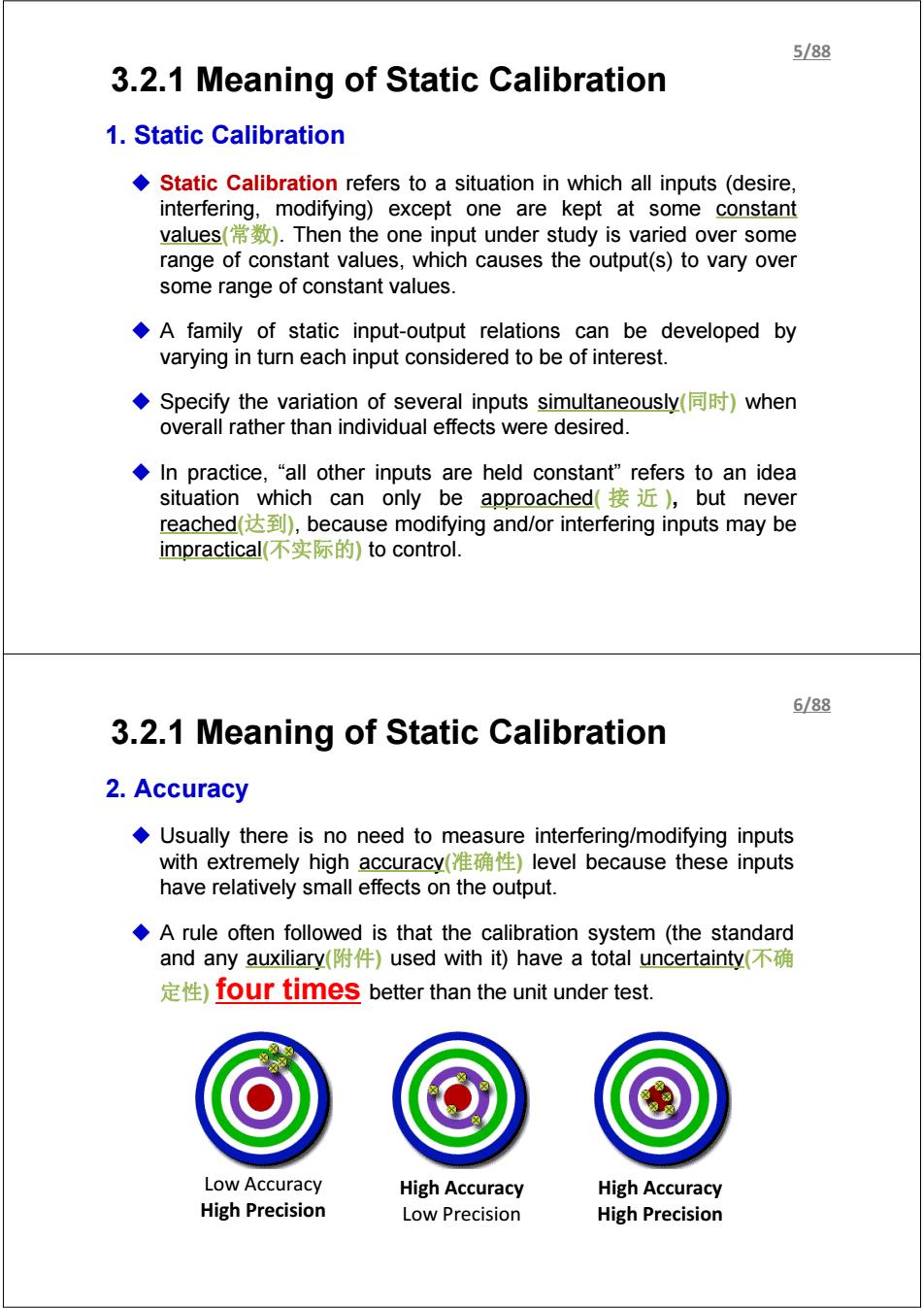
5/88 3.2.1 Meaning of Static Calibration 1.Static Calibration Static Calibration refers to a situation in which all inputs (desire, interfering,modifying)except one are kept at some constant values().Then the one input under study is varied over some range of constant values,which causes the output(s)to vary over some range of constant values. A family of static input-output relations can be developed by varying in turn each input considered to be of interest. ◆Specify the variation of several inputs simultaneously同时)when overall rather than individual effects were desired. ◆In practice,“all other inputs are held constant'”refers to an idea situation which can only be approached(接近,but never reached达到),because modifying and/.or interfering inputs may be impractical(不实际的)to control. 6/88 3.2.1 Meaning of Static Calibration 2.Accuracy Usually there is no need to measure interfering/modifying inputs with extremely high accuracy(准确性)level because these inputs have relatively small effects on the output. A rule often followed is that the calibration system (the standard and any auxiliary(附件)used with it)have a total uncertainty(不确 定性)four times better than the unit under test.. Low Accuracy High Accuracy High Accuracy High Precision Low Precision High Precision
3.2.1 Meaning of Static Calibration 1. Static Calibration Static Calibration refers to a situation in which all inputs (desire, interfering, modifying) except one are kept at some constant values(常数). Then the one input under study is varied over some range of constant values, which causes the output(s) to vary over some range of constant values. A family of static input-output relations can be developed by varying in turn each input considered to be of interest. Specify the variation of several inputs simultaneously(同时) when overall rather than individual effects were desired. In practice, “all other inputs are held constant” refers to an idea situation which can only be approached( 接 近 ), but never reached(达到), because modifying and/or interfering inputs may be impractical(不实际的) to control. 5/88 2. Accuracy Usually there is no need to measure interfering/modifying inputs with extremely high accuracy(准确性) level because these inputs have relatively small effects on the output. A rule often followed is that the calibration system (the standard and any auxiliary(附件) used with it) have a total uncertainty(不确 定性) four times better than the unit under test. 3.2.1 Meaning of Static Calibration Low Accuracy High Precision High Accuracy Low Precision High Accuracy High Precision 6/88
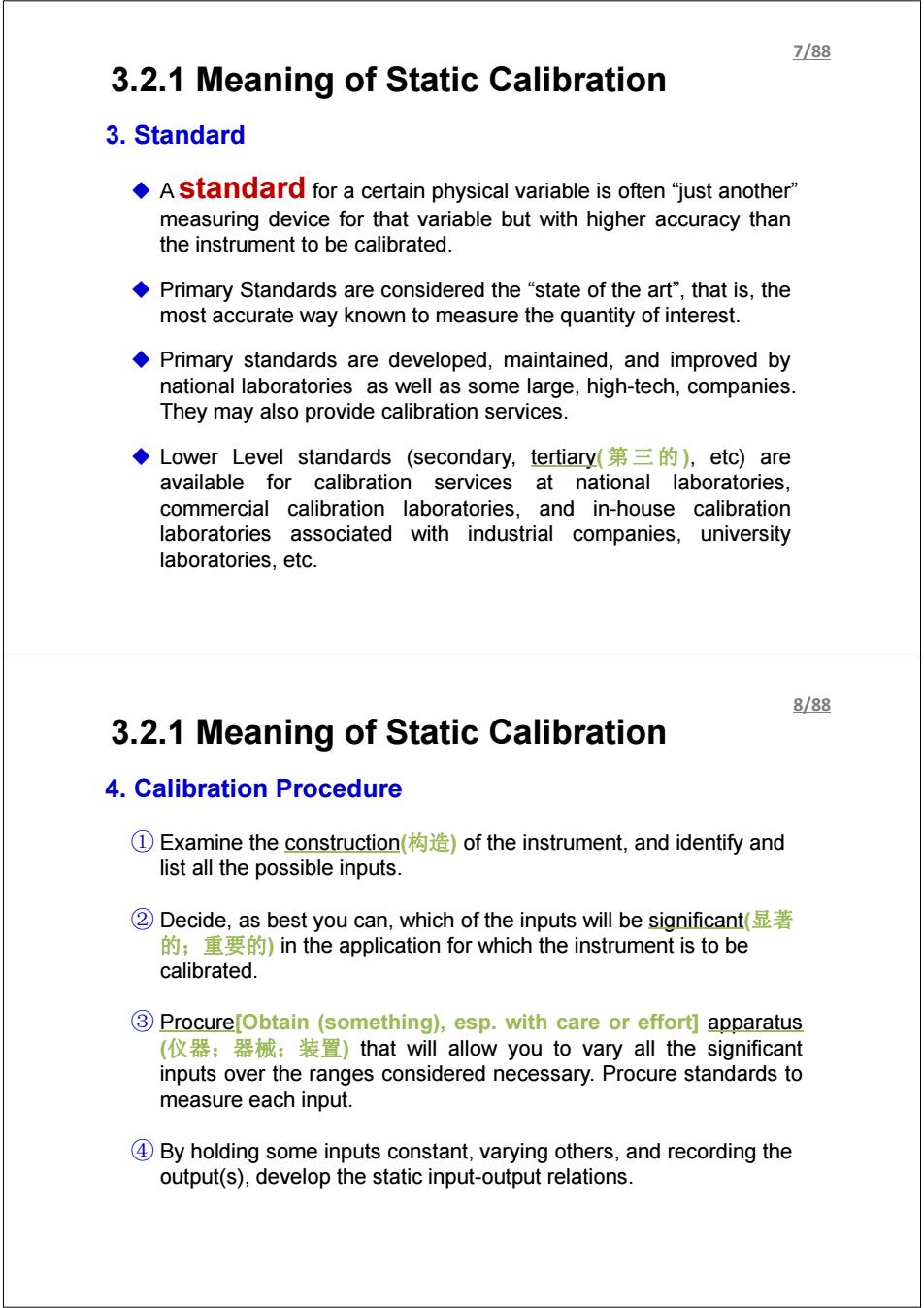
7/88 3.2.1 Meaning of Static Calibration 3.Standard A standard for a certain physical variable is often "just another" measuring device for that variable but with higher accuracy than the instrument to be calibrated. Primary Standards are considered the "state of the art",that is,the most accurate way known to measure the quantity of interest. Primary standards are developed,maintained,and improved by national laboratories as well as some large,high-tech,companies. They may also provide calibration services. ◆Lower Level standards(secondary,.tertiary(第三的),eto)are available for calibration services at national laboratories, commercial calibration laboratories,and in-house calibration laboratories associated with industrial companies,university laboratories,etc. 8/88 3.2.1 Meaning of Static Calibration 4.Calibration Procedure ①Examine the construction(构造)of the instrument,and identify and list all the possible inputs. ②Decide,as best you can,which of the inputs will be significant(显著 的;重要的)in the application for which the instrument is to be calibrated. 3Procure[Obtain (something),esp.with care or effort]apparatus (仪器;器械;装置)that will allow you to vary all the significant inputs over the ranges considered necessary.Procure standards to measure each input. 4By holding some inputs constant,varying others,and recording the output(s),develop the static input-output relations
3. Standard A standard for a certain physical variable is often “just another” measuring device for that variable but with higher accuracy than the instrument to be calibrated. Primary Standards are considered the “state of the art”, that is, the most accurate way known to measure the quantity of interest. Primary standards are developed, maintained, and improved by national laboratories as well as some large, high-tech, companies. They may also provide calibration services. Lower Level standards (secondary, tertiary( 第三的 ), etc) are available for calibration services at national laboratories, commercial calibration laboratories, and in-house calibration laboratories associated with industrial companies, university laboratories, etc. 3.2.1 Meaning of Static Calibration 7/88 4. Calibration Procedure ① Examine the construction(构造) of the instrument, and identify and list all the possible inputs. ② Decide, as best you can, which of the inputs will be significant(显著 的;重要的) in the application for which the instrument is to be calibrated. ③ Procure[Obtain (something), esp. with care or effort] apparatus (仪器;器械;装置) that will allow you to vary all the significant inputs over the ranges considered necessary. Procure standards to measure each input. ④ By holding some inputs constant, varying others, and recording the output(s), develop the static input-output relations. 3.2.1 Meaning of Static Calibration 8/88
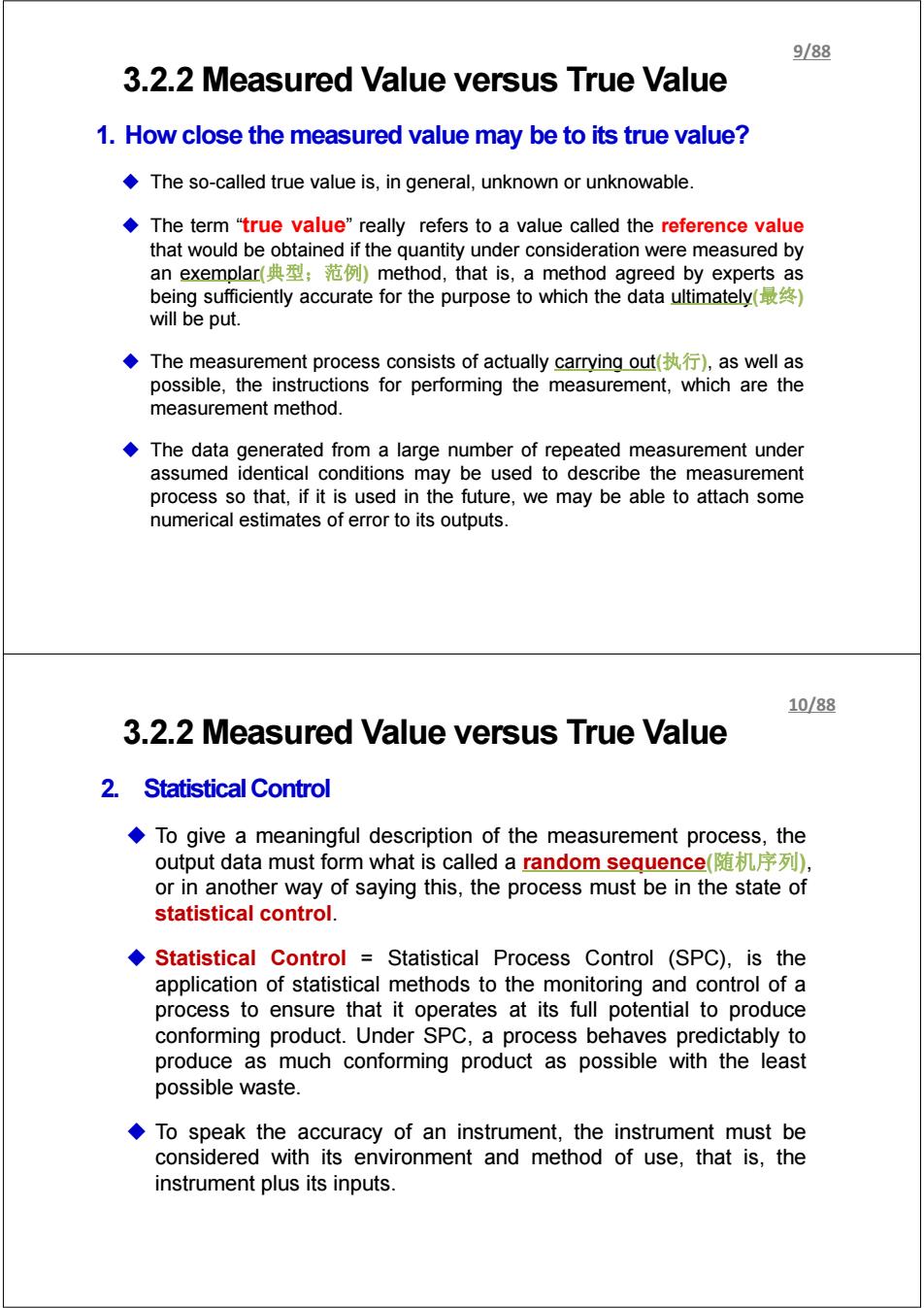
9/88 3.2.2 Measured Value versus True Value 1.How close the measured value may be to its true value? The so-called true value is,in general,unknown or unknowable. The term "true value"really refers to a value called the reference value that would be obtained if the quantity under consideration were measured by an exemplar(典型;范例)method,.that is,.a method agreed by experts as being sufficiently accurate for the purpose to which the data ultimately() will be put. ◆The measurement process consists of actually carrying out(执行),as well as possible,the instructions for performing the measurement,which are the measurement method. The data generated from a large number of repeated measurement under assumed identical conditions may be used to describe the measurement process so that,if it is used in the future,we may be able to attach some numerical estimates of error to its outputs. 10/88 3.2.2 Measured Value versus True Value 2.Statistical Control To give a meaningful description of the measurement process,the output data must form what is called a random sequence(随机序列), or in another way of saying this,the process must be in the state of statistical control. Statistical Control Statistical Process Control (SPC),is the application of statistical methods to the monitoring and control of a process to ensure that it operates at its full potential to produce conforming product.Under SPC,a process behaves predictably to produce as much conforming product as possible with the least possible waste. To speak the accuracy of an instrument,the instrument must be considered with its environment and method of use,that is,the instrument plus its inputs
3.2.2 Measured Value versus True Value 1. How close the measured value may be to its true value? The so-called true value is, in general, unknown or unknowable. The term “true value” really refers to a value called the reference value that would be obtained if the quantity under consideration were measured by an exemplar(典型;范例) method, that is, a method agreed by experts as being sufficiently accurate for the purpose to which the data ultimately(最终) will be put. The measurement process consists of actually carrying out(执行), as well as possible, the instructions for performing the measurement, which are the measurement method. The data generated from a large number of repeated measurement under assumed identical conditions may be used to describe the measurement process so that, if it is used in the future, we may be able to attach some numerical estimates of error to its outputs. 9/88 3.2.2 Measured Value versus True Value 2. Statistical Control To give a meaningful description of the measurement process, the output data must form what is called a random sequence(随机序列), or in another way of saying this, the process must be in the state of statistical control. Statistical Control = Statistical Process Control (SPC), is the application of statistical methods to the monitoring and control of a process to ensure that it operates at its full potential to produce conforming product. Under SPC, a process behaves predictably to produce as much conforming product as possible with the least possible waste. To speak the accuracy of an instrument, the instrument must be considered with its environment and method of use, that is, the instrument plus its inputs. 10/88